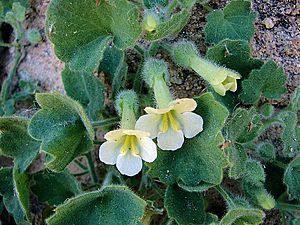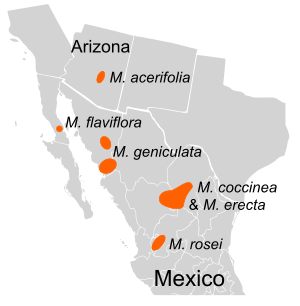Mabrya facts for kids
Quick facts for kids Mabrya |
|
|---|---|
 |
|
| Mabrya acerifolia | |
| Scientific classification |
|
| Kingdom: | Plantae |
| Clade: | Tracheophytes |
| Clade: | Angiosperms |
| Clade: | Eudicots |
| Clade: | Asterids |
| Order: | Lamiales |
| Family: | Plantaginaceae |
| Tribe: | Antirrhineae |
| Genus: | Mabrya Elisens |
| Species | |
Mabrya is a group of flowering plants that belong to the plantain family, called Plantaginaceae. These plants are herbaceous (meaning they have soft stems, not woody ones) and are perennials, which means they live for more than two years. You can find them in dry areas of Mexico and the southern United States. They often have stems that hang down or stand upright, and they can be quite brittle.
Contents
What Does Mabrya Look Like?
Mabrya plants are herbaceous perennials with roots that look like fibers. Their stems are usually brittle and often hang down, forming flat mats. However, one species, M. erecta, has more upright stems. As the plants get older, their stems branch out and become a bit woody at the bottom.
Unlike some related plants, Mabrya has straight leaf stalks (petioles) that do not twist around things. Their leaves are round or kidney-shaped. They usually have wide, somewhat rounded teeth along their edges.
Mabrya Flowers
The flowers of Mabrya grow one by one on stalks (peduncles) that usually stick out sideways or point upwards. The sepals (the leaf-like parts that protect the bud) are joined at their base. Where their edges become free, they curve backwards. Together, the sepals form a cup-shaped structure called a calyx.
Each flower has five petals that are joined at their base to form a tube. The free parts of the petals are divided into two upper parts that curve backwards and three lower parts that either point forward or also curve backwards. The flowers are usually whitish at the bottom. Then, they can be cream, yellow, pink, red, or reddish-violet.
Inside the flower, there are four working stamens (the parts that produce pollen) of two different lengths. There is also one tiny stamen that doesn't work. The stamens and the style (part of the female reproductive organ) are either hidden inside the flower or stick out. The stigma (the part that receives pollen) is forked, meaning it splits into two. After the flower is fertilized, it forms a two-chambered seed capsule. This capsule holds tan or dark brown seeds.
How Mabrya Got Its Name
The group of plants called Mabrya was officially named by Wayne J. Elisens in 1985. He created this new group to separate several species that were previously placed in a different group called Maurandya. The first species chosen to represent this new group was Mabrya acerifolia.
The name Mabrya was chosen to honor Tom J. Mabry. He was a scientist who studied plant chemistry and how plants are classified. Elisens said that Mabry's work greatly improved our understanding of plants in North America.
Mabrya's Plant Family Tree
Mabrya belongs to a larger plant group called the tribe Antirrhineae. Mabrya plants have brittle stems that either hang down or stand up. This feature helps tell them apart from closely related groups like Lophospermum, Maurandya, and Rhodochiton. Those other plants have longer, flexible stems and climb by twisting their leaf stalks.
The ovary (the part of the flower that holds the seeds) of Mabrya has two compartments. This is different from Holmgrenanthe, which has an ovary with only one compartment.
Scientists have used molecular studies (looking at DNA) to understand how these plants are related. These studies show that a group called Maurandyinae, which includes Holmgrenanthe, Lophospermum, Mabrya, Maurandya, and Rhodochiton, forms a natural family group. This group is related to some older plant groups from other parts of the world, like Cymbalaria and Asarina.
Here is a diagram showing how these plants are related: {{barlabel |size=8 |at1=2.5|label1=Old World |at2=5.5|label2=New World |cladogram=
| Antirrhineae |
|
|||||||||||||||||||||||||||||||||||||||||||||
Scientists believe that the Antirrhineae group first appeared in the "Old World" (Europe, Asia, Africa). Then, they spread to North America more than once, likely during the Miocene epoch (a long time ago!). One of these migrations led to the development of the Maurandyinae group in North America.
Species of Mabrya
As of July 2014, The Plant List recognizes six different species within the Mabrya group:
- Mabrya acerifolia (Pennell) Elisens
- Mabrya coccinea (I.M.Johnst.) Elisens
- Mabrya erecta (Hemsl.) Elisens
- Mabrya flaviflora (I.M.Johnst.) D.A.Sutton
- Mabrya geniculata (B.L.Rob. & Fernald) Elisens
- Mabrya rosei (Munz) Elisens
Originally, Mabrya flaviflora was considered a subspecies of Mabrya geniculata. However, a scientist named David A. Sutton later decided it was different enough to be its own full species.
Where Mabrya Lives
All Mabrya species live in very dry places. They often grow on shaded cliffs or in canyons. Mabrya acerifolia is found in the Sonoran Desert in a small area of about 80 kilometers (50 miles) across in south-central Arizona.
All the other species are found only in Mexico. M. geniculata and M. flaviflora also live in the Sonoran Desert, with M. flaviflora only in Baja California Norte. M. coccinea and M. erecta are found in the Chihuahuan Desert. Finally, M. rosei grows in the Mexican states of Jalisco and Zacatecas.
Mabrya's Life and Pollination
Scientists haven't observed many pollinators for Mabrya plants. However, Elisens thinks that most Mabrya species are pollinated by hummingbirds. It's also possible that long-tongued bees help with pollination.
The sweet liquid (nectar) inside most Mabrya flowers is similar to that of other plants known to be pollinated by hummingbirds. It has a lot of sucrose (a type of sugar) and less glucose compared to fructose. This kind of nectar is often preferred by hummingbirds.
See also
 In Spanish: Mabrya para niños
In Spanish: Mabrya para niños


